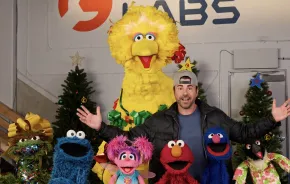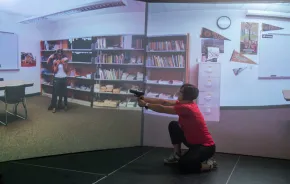
Story time
Attending a regular story time at your local library or bookstore will not only be a joyous and social experience for your child, but will begin forming their relationship with books.
Wordless books
“Reading” all-image classics, such as David Wiesner’s “Flotsam,” helps kids pay attention to all the other aspects of telling a story besides words on a page. Have fun filling in the story as you go.
Dine and read
Seattle chef and food writer Jackie Freeman’s family loves graphic novels and dim sum, so they combine those two passions with a regular brunch in the Chinatown–International District, followed by a trip to Uwajimaya’s bookstore. “Reading is reading, whether it’s comics or classics!” she says.
Connect with authors
Connecting kids to favorite authors can draw in reluctant readers. Look for events at bookstores and libraries. Check authors’ websites; many have ways for kids to write to them, extra chapters to download and more ways to engage.
Fabulous fan fiction
Your kid might be a beginning reader but an expert Minecrafter or Fortniter. Fan fiction and activity books related to their obsession might be just the ticket.
Tell family stories
Kids can learn all kinds of things from the low-tech tradition of telling great family stories, such as how narratives work, and how to build character and tension.
Outsource the read-aloud
Skype with the grandparents for a special story time once a week. Fire up digital story times through TumbleBooks’ animated talking-picture books, which is a public library service, or related services, such as BookFlix.
Parallel podcast listening
Podcasts are like mini audiobooks and easy to listen to together, either through a speaker or simultaneously on your favorite devices. Our recent favorite, for kids ages 8 and older: “The Unexplainable Disappearance of Mars Patel.”
Read everything
ParentMap writer Diana Cherry — a mother of four, including two children with dyslexia — has motivated her reluctant readers through many methods, from setting out cookbooks and asking a child to pick the week’s meals to having them plan the weekend’s activities by reading about them.
Keep reading aloud
Who says you can’t read aloud with teenagers? Although their daughters are both teens, Seattle parent educator Sarina Behar Natkin and her husband still read to them every night. Their daughters’ increasingly sophisticated book selections often offer a way to talk about difficult topics. “We can share with them things that we may not know how to talk about,” says Behar Natkin. “Books can give us the language we don’t have.”
Bonus tip: Peruse these great book lists
- “Better With Books: 500 Diverse Books to Ignite Empathy and Encourage Self-Acceptance in Tweens and Teens” by Melissa Hart. With 500 recommendations, this book is an essential guide for every family.
- What Do We Do All Day? Founded by a Gen X mom, this website has more than 200 reading lists plus oodles of ideas for unplugged games.
- Common Sense Media reviews. Common Sense Media has lots of book reviews to help you sort through appropriate subject and reading matter for kids of all ages.
- A Mighty Girl. Dedicated to all things girl power, this cool site presents lots of great lists featuring books with strong female characters.
- “The Read-Aloud Handbook” by Jim Trelease. This classic treasury of fantastic read-alouds is in its eighth edition. Sarah Mackenzie’s “The Read-Aloud Family” is another great resource.
- ParentMap book lists. Looking for great sibling stories? Terrific graphic novels? Find a bounty of book lists on parentmap.com.
- Libraries. In addition to children’s librarians, public libraries offer many online resources. Find terrific book lists (and audiobook lists) on library websites, or fill out a “Your Next 5 Books” profile (at the Seattle Public Library) or Book Match profile (through the King County Library System) to receive customized picks by email.
Spotting reading red flags
“It always used to break my heart when I’d get these calls from parents in the middle of kindergarten: ‘Oh my god, my kid isn’t reading yet,’” says literacy expert Jennifer Bloch Garcia. “One thing we know about brain development is that some brains aren’t ready to learn until they’re 6.”
So, if your kid isn’t reading fluently by that age, relax. That said, one in five children have dyslexia or some other language-based learning delay, so if you do spot red flags, check in with your child’s teacher. According to the International Dyslexia Association, signs of dyslexia can include difficulty with directions, distinguishing sounds, pronunciation, rhyming, learning the alphabet, word retrieval, establishing connections between letters and sounds, and spelling phonetically. Vision and processing disorders can also cause reading delays.
The good news: A new Washington state law, passed in 2018, mandates early screening, identification and intervention for language-based learning disabilities. The law will take effect in September 2021.
Want more resources? Check the Washington state branch of the International Dyslexia Association’s website. Hamlin Robinson School, a private K–8 school in Seattle that specializes in serving kids with dyslexia, is another helpful resource.
Editor’s note: This article was originally published in September 2019, and updated in August 2021.











